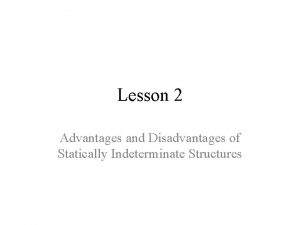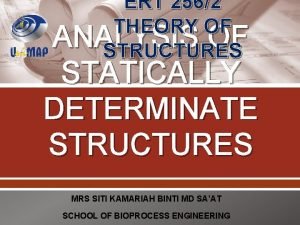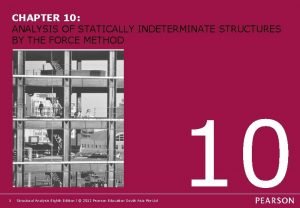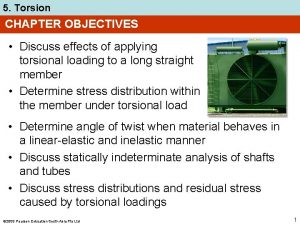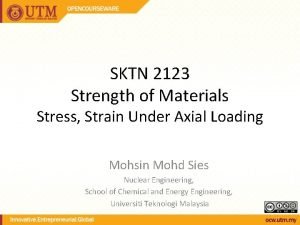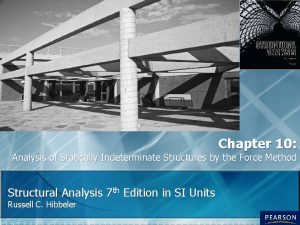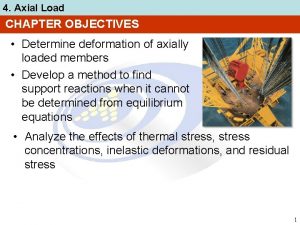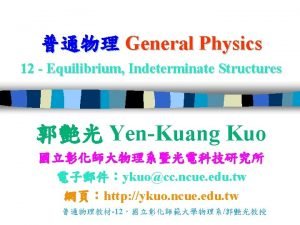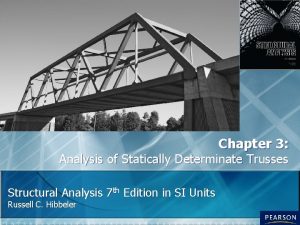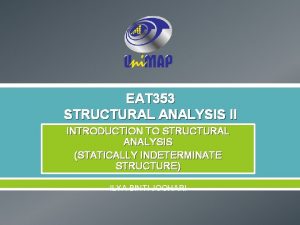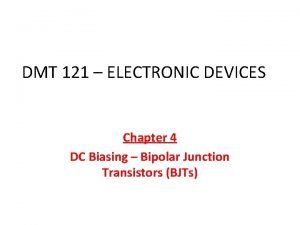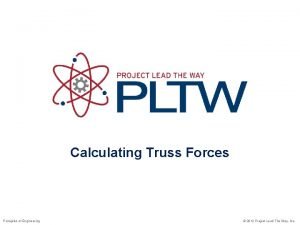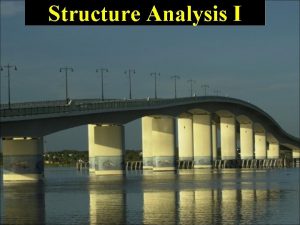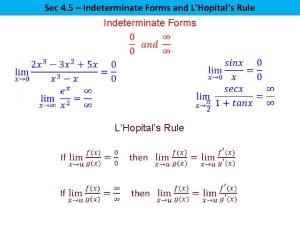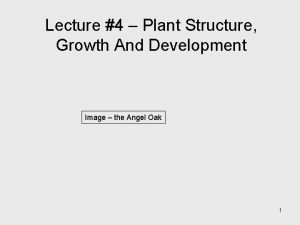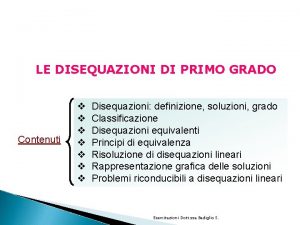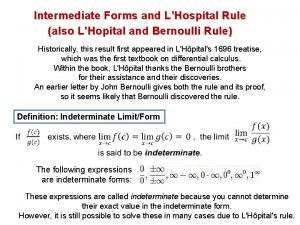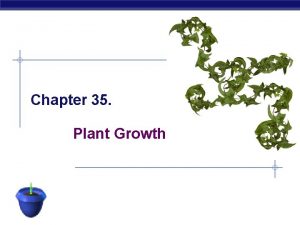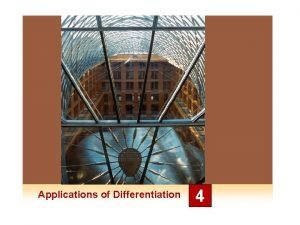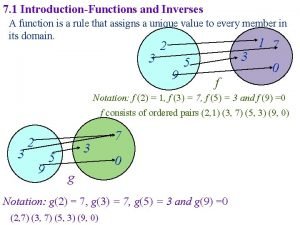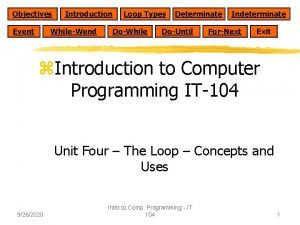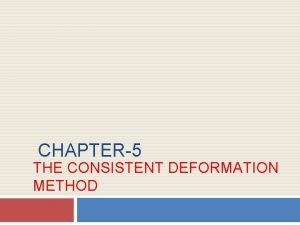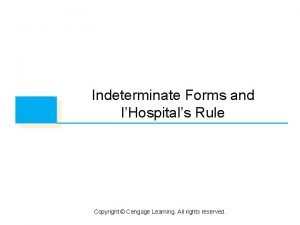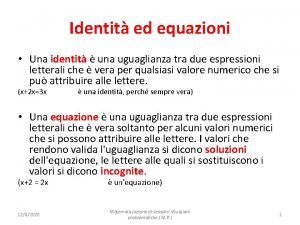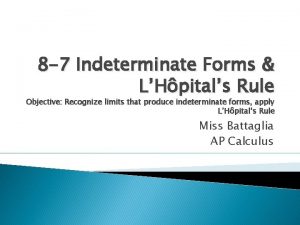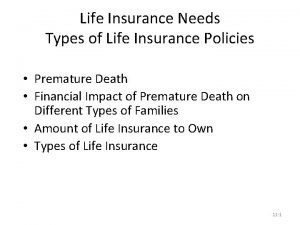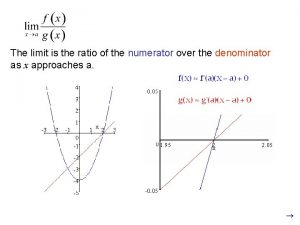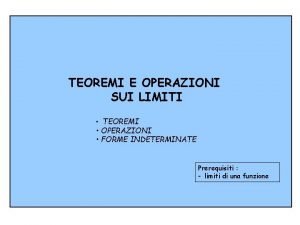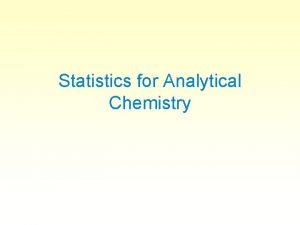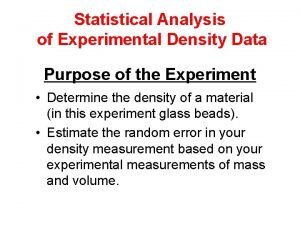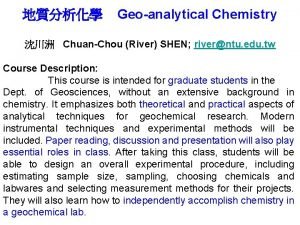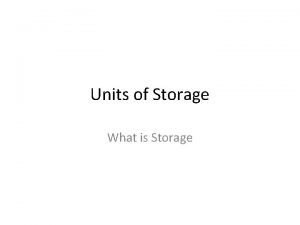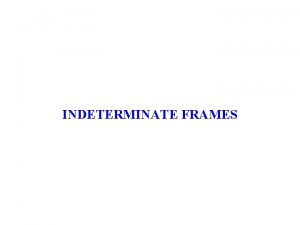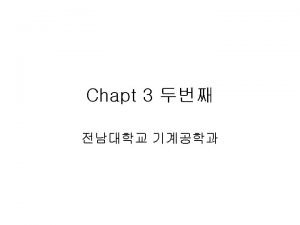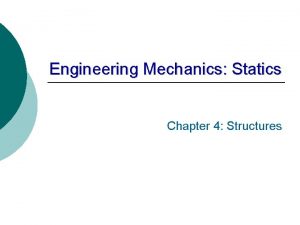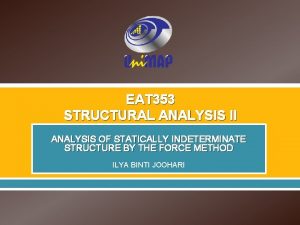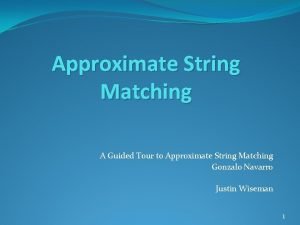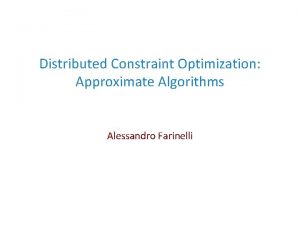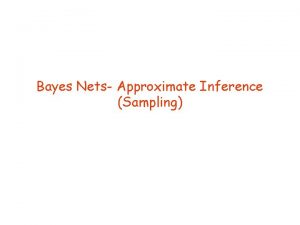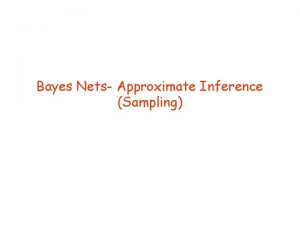Chapter 7 Approximate Analysis of Statically Indeterminate Structures










































- Slides: 42

Chapter 7: Approximate Analysis of Statically Indeterminate Structures Structural Analysis 7 th Edition in SI Units Russell C. Hibbeler

Use of approximate methods • The analysis when using a model must satisfy both the conditions of: • Equilibrium • Compatibility of displacements at joints • For an initial design, member sizes are not known & statically indeterminate analysis cannot be done • A simpler model must be developed, i. e. , a statically determinate analysis Chapter 7: Approximate Analysis of Statically Indeterminate Structures © 2009 Pearson Education South Asia Pte Ltd Structural Analysis 7 th Edition

Use of approximate methods • The analysis of this model is known as an approximate analysis • The preliminary design of the members can be made • After which, the more exact indeterminate analysis can be performed & the design refined Chapter 7: Approximate Analysis of Statically Indeterminate Structures © 2009 Pearson Education South Asia Pte Ltd Structural Analysis 7 th Edition

Trusses • The truss used for lateral bracing of a building is not considered a primary element • It will therefore be analysed using approximate methods • Hence, the truss is indeterminate to the third degree Chapter 7: Approximate Analysis of Statically Indeterminate Structures © 2009 Pearson Education South Asia Pte Ltd Structural Analysis 7 th Edition

Trusses • 3 assumptions must be made in order to reduce the truss to one that is statically determinate • Assumptions may be made in regards with the following: • When 1 diagonal in the panel is in tension, the corresponding cross diagonal will be in compression Chapter 7: Approximate Analysis of Statically Indeterminate Structures © 2009 Pearson Education South Asia Pte Ltd Structural Analysis 7 th Edition

Trusses • Two methods of analysis are generally acceptable: • Method 1 • If the diagonals are intentionally designed to be long & slender, it is reasonable to assume they cannot support compression force • Otherwise, they may easily buckle • Hence, the compressive diagonal is assumed to be zero-force member Chapter 7: Approximate Analysis of Statically Indeterminate Structures © 2009 Pearson Education South Asia Pte Ltd Structural Analysis 7 th Edition

Trusses • Method 2 • If the diagonals are intended to be constructed from large rolled sections such as angles or channels, they may be equally capable of supporting a tensile & compressive force • We will assume that tension & compression diagonals each carry half the panel shear Chapter 7: Approximate Analysis of Statically Indeterminate Structures © 2009 Pearson Education South Asia Pte Ltd Structural Analysis 7 th Edition

Example 7. 1 Determine (approximately) the forces in the members of the truss. The diagonals are to be designed to support both tensile and compressive forces, and therefore each is assumed to carry half the panel shear. The support reactions have been computed. Chapter 7: Approximate Analysis of Statically Indeterminate Structures © 2009 Pearson Education South Asia Pte Ltd Structural Analysis 7 th Edition

Solution By inspection, the truss is statically indeterminate to the second degree. The 2 assumptions require the tensile & compressive diagonals to carry equal forces. For a vertical section through the left panel, we have: Chapter 7: Approximate Analysis of Statically Indeterminate Structures © 2009 Pearson Education South Asia Pte Ltd Structural Analysis 7 th Edition

Solution Chapter 7: Approximate Analysis of Statically Indeterminate Structures © 2009 Pearson Education South Asia Pte Ltd Structural Analysis 7 th Edition

Solution Chapter 7: Approximate Analysis of Statically Indeterminate Structures © 2009 Pearson Education South Asia Pte Ltd Structural Analysis 7 th Edition

Solution Chapter 7: Approximate Analysis of Statically Indeterminate Structures © 2009 Pearson Education South Asia Pte Ltd Structural Analysis 7 th Edition

Vertical loads on building frames • Building frames often consist of girders that are rigidly connected to columns • This is to allow the structure to better able to resist the effects of lateral forces Chapter 7: Approximate Analysis of Statically Indeterminate Structures © 2009 Pearson Education South Asia Pte Ltd Structural Analysis 7 th Edition

Vertical loads on building frames • One technique would be to consider only the members within a localised region of the structure • This is possible if the deflections of the members within the region caused little disturbance to the members outside the structure • The approximate location of the points of inflection can be specified • These points are zero moments Chapter 7: Approximate Analysis of Statically Indeterminate Structures © 2009 Pearson Education South Asia Pte Ltd Structural Analysis 7 th Edition

Vertical loads on building frames • Assumptions for approximate analysis • The column supports at A & B will each exert 3 reactions on the girder • The girder will be statically indeterminate to the third degree • 3 assumptions would be needed to perform an approximate analysis Chapter 7: Approximate Analysis of Statically Indeterminate Structures © 2009 Pearson Education South Asia Pte Ltd Structural Analysis 7 th Edition

Vertical loads on building frames • Assumptions for approximate analysis • If the columns are stiff, no rotation at A & B will occur • However, if the column connections at A & B are very flexible, then zero moments will occur at the supports • In reality, the columns will provide some flexibility at the supports Chapter 7: Approximate Analysis of Statically Indeterminate Structures © 2009 Pearson Education South Asia Pte Ltd Structural Analysis 7 th Edition

Vertical loads on building frames • Assumptions for approximate analysis • Therefore, point of zero moment occurs at the average point between the two extremes (0. 21 L+0) / 2 ~ 0. 1 L from each support Chapter 7: Approximate Analysis of Statically Indeterminate Structures © 2009 Pearson Education South Asia Pte Ltd Structural Analysis 7 th Edition

Vertical loads on building frames • Assumptions for approximate analysis • The 3 assumptions are: • There is zero moment in the girder, 0. 1 L from the left support • There is zero moment in the girder, 0. 1 L from the right support • The girder does not support an axial force Chapter 7: Approximate Analysis of Statically Indeterminate Structures © 2009 Pearson Education South Asia Pte Ltd Structural Analysis 7 th Edition

Example 7. 3 Determine (approximately) the moment at the joints E and C caused by members EF and CD of the building bent. Chapter 7: Approximate Analysis of Statically Indeterminate Structures © 2009 Pearson Education South Asia Pte Ltd Structural Analysis 7 th Edition

Solution For an approximate analysis, the frame is modeled as shown. Note that the cantilevered spans supporting the center portion of the girder have a length of 0. 1 L = 0. 5 m Equilibrium requires end reaction of center portion = 32 k. N Chapter 7: Approximate Analysis of Statically Indeterminate Structures © 2009 Pearson Education South Asia Pte Ltd Structural Analysis 7 th Edition

Solution Cantilevered spans are subjected to moment of: This approximate moment with opposite direction acts on the joints at E & C. Chapter 7: Approximate Analysis of Statically Indeterminate Structures © 2009 Pearson Education South Asia Pte Ltd Structural Analysis 7 th Edition

Portal Frames & Trusses • Portal frames are used to transfer horizontal forces applied at the top of frame to the foundation • Portals can be pin supported, fixed supported or supported by partial fixity Chapter 7: Approximate Analysis of Statically Indeterminate Structures © 2009 Pearson Education South Asia Pte Ltd Structural Analysis 7 th Edition

Portal Frames & Trusses • We analyse the trussed portals using the same assumptions as those for simple portal frames • For pin-supported column, assume horizontal shear are equal • For fixed-supported column, assume horizontal reactions are equal and an point of inflection occurs on each column, midway between base of column & the lowest point of truss member connection to column Chapter 7: Approximate Analysis of Statically Indeterminate Structures © 2009 Pearson Education South Asia Pte Ltd Structural Analysis 7 th Edition

Example 7. 4 Determine by approximate methods the forces acting in the members of the Warren portal. Chapter 7: Approximate Analysis of Statically Indeterminate Structures © 2009 Pearson Education South Asia Pte Ltd Structural Analysis 7 th Edition

Solution The truss portion B, C, F, G acts as a rigid unit A point of inflection is assumed to exist at 7 m/2 = 3. 5 m above A &I Equal horizontal reactions act at the base of the column Determine the reactions at the columns as follows: Lower half of column Upper half of column Chapter 7: Approximate Analysis of Statically Indeterminate Structures © 2009 Pearson Education South Asia Pte Ltd Structural Analysis 7 th Edition

Solution Using the method of sections, we can proceed to obtain the forces in members CD, BD & BH Chapter 7: Approximate Analysis of Statically Indeterminate Structures © 2009 Pearson Education South Asia Pte Ltd Structural Analysis 7 th Edition

Solution Using this results we can find the forces in each of the other truss members using method of joints The results are summarised as Chapter 7: Approximate Analysis of Statically Indeterminate Structures © 2009 Pearson Education South Asia Pte Ltd Structural Analysis 7 th Edition

Lateral loads on building frames: Portal method • A building bent deflects in the same way as portal frame • Each bent of the frame can be considered as a series of portals • The interior columns would represent the effect of 2 portal columns & would carry 2 x the shear V as the exterior columns Chapter 7: Approximate Analysis of Statically Indeterminate Structures © 2009 Pearson Education South Asia Pte Ltd Structural Analysis 7 th Edition

Lateral loads on building frames: Portal method • The portal method for analyzing fixed supported building frames requires the following assumptions: • A hinge is placed at the center of each girder • A hinge is placed at the center of each column • At a given floor level, the shear at the int column hinges is 2 x that at the ext column hinges Chapter 7: Approximate Analysis of Statically Indeterminate Structures © 2009 Pearson Education South Asia Pte Ltd Structural Analysis 7 th Edition

Lateral loads on building frames: Portal method • These assumptions provide an adequate reduction of the frame to one that is statically determinate and yet stable under loading • This method is more suitable for buildings having low elevation and uniform framing Chapter 7: Approximate Analysis of Statically Indeterminate Structures © 2009 Pearson Education South Asia Pte Ltd Structural Analysis 7 th Edition

Example 7. 5 Determine (approximately) the reactions at the base of the columns of the frame. Use the portal method of analysis. Chapter 7: Approximate Analysis of Statically Indeterminate Structures © 2009 Pearson Education South Asia Pte Ltd Structural Analysis 7 th Edition

Solution Applying the first 2 assumptions of the portal method, we place hinges at the centers of the girders & columns of the frame. A section through the column hinges at I, J, K & L yields the free body diagram. The third assumption regarding the column shear applies. Chapter 7: Approximate Analysis of Statically Indeterminate Structures © 2009 Pearson Education South Asia Pte Ltd Structural Analysis 7 th Edition

Solution Using this result, we proceed to dismember the frame at the hinges & determine their reactions. As a general rule, always start analysis at the corner or joint where the horizontal load is applied. The free-body diagram of segment IBM is shown. The 3 reactions components at the hinges are determined by applying Chapter 7: Approximate Analysis of Statically Indeterminate Structures © 2009 Pearson Education South Asia Pte Ltd Structural Analysis 7 th Edition

Solution The adjacent segment MJN is analyzed next. This is followed by segment NKO and OGL. Using these results, the free body diagram of the columns with their support reactions are shown. Chapter 7: Approximate Analysis of Statically Indeterminate Structures © 2009 Pearson Education South Asia Pte Ltd Structural Analysis 7 th Edition

Lateral loads on building frames: Cantilever method • This method is based on the same action as a long cantilevered beam subjected to a transverse load • This causes a bending stress that varies linearly from the beam’s neutral axis • In a similar manner, the lateral loads on a frame tends to tip the frame over or cause a rotation about a neutral axis lying in the horizontal plane that passes through the columns at each floor level Chapter 7: Approximate Analysis of Statically Indeterminate Structures © 2009 Pearson Education South Asia Pte Ltd Structural Analysis 7 th Edition

Lateral loads on building frames: Cantilever method • To counter this, the axial forces in the columns will be tensile on one side of the neutral axis & compressive on the other side • It is reasonable to assume this axial stress has a linear variation from the centroid of the neutral axis • This method is appropriate if the frame is tall & slender or has columns with different x-sectional areas Chapter 7: Approximate Analysis of Statically Indeterminate Structures © 2009 Pearson Education South Asia Pte Ltd Structural Analysis 7 th Edition

Lateral loads on building frames: Cantilever method • The following assumptions apply for a fixed support frame • A hinge is placed at the center of each girder • A hinge is placed at the center of each column • The axial stress in a column is proportional to its distance from the centroid of the cross-sectional areas of the columns at a given floor level Chapter 7: Approximate Analysis of Statically Indeterminate Structures © 2009 Pearson Education South Asia Pte Ltd Structural Analysis 7 th Edition

Lateral loads on building frames: Cantilever method • Since stress = force per area, then in the case of equal cross-sectional areas, the force in a column is proportional to its distance from the centroid • These assumptions reduce the frame to one that is both stable & statically determinate Chapter 7: Approximate Analysis of Statically Indeterminate Structures © 2009 Pearson Education South Asia Pte Ltd Structural Analysis 7 th Edition

Example 7. 7 Determine (approximately) the reactions at the base of the columns of the frame. The columns are assumed to have equal cross-sectional areas. Use the cantilever method of analysis. Chapter 7: Approximate Analysis of Statically Indeterminate Structures © 2009 Pearson Education South Asia Pte Ltd Structural Analysis 7 th Edition

Solution Hinges are placed at midpoints of the columns & girders. The locations of these points are indicated by the letters G through L. The axial force in each column is ~ distance from this point. A section through the hinges H and K at the top floor yields the free body diagram as shown. Chapter 7: Approximate Analysis of Statically Indeterminate Structures © 2009 Pearson Education South Asia Pte Ltd Structural Analysis 7 th Edition

Solution In a similar manner, using a section of the frame through the hinges at G & L, we have: Chapter 7: Approximate Analysis of Statically Indeterminate Structures © 2009 Pearson Education South Asia Pte Ltd Structural Analysis 7 th Edition

Solution Each part of the frame can be analysed using the above results. Beginning with the upper corner where the applied loading occurs, segment HCI. Applying eqn of equilibrium yields the results for Hx, Ix and Iy. Using these results, segment IDK is analysed next followed by HJG & KJL. Finally the bottom portions of the columns. Chapter 7: Approximate Analysis of Statically Indeterminate Structures © 2009 Pearson Education South Asia Pte Ltd Structural Analysis 7 th Edition
 A building bent deflects in the way same as a:
A building bent deflects in the way same as a: Advantages and disadvantages of determinate structures
Advantages and disadvantages of determinate structures Improperly constrained
Improperly constrained Statically determinate and indeterminate structures
Statically determinate and indeterminate structures Tl/jg formula
Tl/jg formula St venant principle
St venant principle Statically indeterminate
Statically indeterminate Advantages and disadvantages of indeterminate structures
Advantages and disadvantages of indeterminate structures St venant principle
St venant principle Statically indeterminate beam fixed at both ends
Statically indeterminate beam fixed at both ends Classify each of the structures as statically determinate
Classify each of the structures as statically determinate Determinate and indeterminate structure
Determinate and indeterminate structure Voltage divider bias configuration
Voltage divider bias configuration Identify the zero force members in the truss
Identify the zero force members in the truss Static determinacy pltw
Static determinacy pltw Statically determinate
Statically determinate Examples of homologous
Examples of homologous Lhopitals rule
Lhopitals rule Indeterminate growth
Indeterminate growth Rappresentazione grafica disequazioni di primo grado
Rappresentazione grafica disequazioni di primo grado Intermediate form of limits
Intermediate form of limits Apical meristem
Apical meristem Types of indeterminate forms
Types of indeterminate forms General derivative formula
General derivative formula Determinate and indeterminate loop in vb
Determinate and indeterminate loop in vb Method of consistent deformation
Method of consistent deformation Indeterminate product
Indeterminate product Identità ed equazioni
Identità ed equazioni 7 indeterminate forms
7 indeterminate forms Indeterminate premium policy
Indeterminate premium policy Indeterminate forms
Indeterminate forms Forme indeterminate limiti
Forme indeterminate limiti Determinate and indeterminate errors
Determinate and indeterminate errors Bottom of the meniscus
Bottom of the meniscus Slope deflection method definition
Slope deflection method definition Difference between determinate and indeterminate structure
Difference between determinate and indeterminate structure Indeterminate sentencing juvenile
Indeterminate sentencing juvenile River shen
River shen Bits bytes kilobytes
Bits bytes kilobytes Approximate computing
Approximate computing Approximate 645 to the nearest hundred
Approximate 645 to the nearest hundred Poem of imagery
Poem of imagery Periods of music
Periods of music

